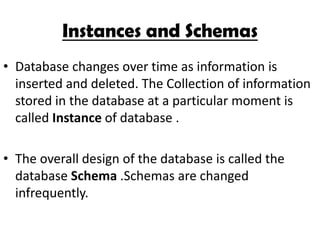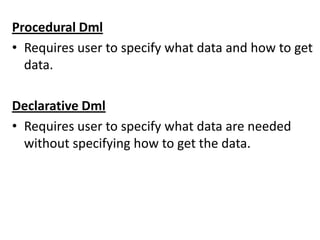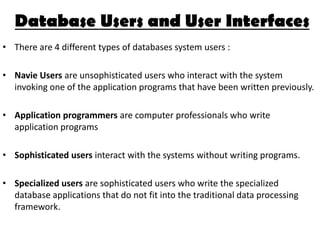Utsav Mahendra : Introduction to Database and managemnet
- 1. INTRODUCTION DATABASE DESIGN AND MANAGEMENT MADE BY : UTSAV MAHENDRA BBA 4502/09 AKSHAY KALRA BBA 4514/09
- 2. Database Management System • Database Management System is a collection of interrelated data and a set of programs to access those data. • Primary Goal of DBMS- provide a way to store and retrieve database. • Management of data involves both defining structure for storage of information and proving mechanisms for the manipulation of information.
- 3. Database System Applications • Banking • Airlines • Universities • Credit card transactions • Telecommunications • Finance • Sales • Manufacturing • Human resources
- 4. File System • File processing system is supported by a conventional operating system. • This System stores permanent records in various files and it needs different application programs to extract and Add records. • Keeping Organizational information in a file- processing system has number of major disadvantages.
- 5. Disadvantages of File System • Data Redundancy and Inconsistency • Difficulty in accessing data • Data isolation • Integrity problems • Security problems
- 6. View of Data 1. Data Abstraction 2. Instances 3. Schema
- 7. Data Abstraction • For the system to be usable ,it must retrieve data efficiency. • The need for efficiency has led designers to use complex data structures to represent data in the database. • Since many database system users are not computer trained, developers hide the complexity from users through several levels of abstractions.
- 8. Levels of Abstraction 1. Physical Level : The lowest level of abstraction describes how the data are actually stored. 2. Logical Level : The next – higher level of abstraction describes what data to be stored in database. 3. View Level : The highest level of abstraction describes only a part of the entire database.
- 9. Instances and Schemas • Database changes over time as information is inserted and deleted. The Collection of information stored in the database at a particular moment is called Instance of database . • The overall design of the database is called the database Schema .Schemas are changed infrequently.
- 10. • Database system have several schemas partitioned according to the levels of abstraction. • Physical schema describes the database design at physical level • Logical schema describes the database design at the logical level. • Database may have several schemas at view level, sometimes called Subschemas, that describes different views of database.
- 11. Data Models • Structure of Database is the Data Model. • A Collection of Conceptual tools for describing Data, Data Relationships, Data Semantics and consistency constraints. The Concept of Data Model has 2 sections 1.The Entity Relationship Model 2.The Relational Model
- 12. The Entity Relationship Model • The Entity Relationship Model ( E.R Model ) is based on the perception of a real world that consists of a collection of basic objects called Entities. • An Entity is a thing or Object in the real world what is distinguishable from other objects. • For example each person is an Entity and bank Accounts can be considered as Entities. • Entities are described in the database by set of attributes.
- 13. • A relationship is an association among several Entities. Eg: Rectangle which represent Entity Sets. Eclipses which represent Attributes. Diamonds which represent Relationship among Entity sets. Lines which link attributes to Entity Sets and Entity Sets relationships
- 14. Relational Model • The Relational Model uses a collection of tables to represent both data and the relationships among those data. • Each table has Multiple Columns, Each Columns has a Unique name. • The Relational Model is an Example or Record Based Model. • Record Based Model is the database structured in fixed formats records of several types.
- 15. • Each table contains records of a particular type each record type defines a fixed number of files or attributes. • The Relational model is at the lower level of Abstraction than the ER Model and then translated to the Relational Model
- 16. Other Data Model • The Object Oriented Data Model is another data model that has seen increasing attention. • The Object Oriented Model can be seen as Extending of the ER Model with notions of Encapsulation, Methods and Object identity. • The Object relational Data Model combines features of the Object Oriented Data Model and Relational Data Model.
- 17. Data Base Language • A Database system provides a data definition language to specify the database schedule and a data Manipulation languages to Express database queries and updates. Data Definition Language • A Database schema by set of definitions Expressed by a special language called Data Definition Language.
- 18. Data Manipulation Language • Retrieval of Information stored in Database. • Insertion of New Information in Database. • Decision of Information from Database. • Modification of Information stored in Database. • Enables User to access or Manipulate data as organized by Appropriate Data Model.
- 19. Procedural Dml • Requires user to specify what data and how to get data. Declarative Dml • Requires user to specify what data are needed without specifying how to get the data.
- 20. Database Access for Application Programs • Application programs used to interact with database application programs written in C,C++,Cobol or Java. • By Providing an application programs can be used to send DML and DDL statements. • By Extending the Host Language syntax to embed DML calls
- 21. Database Users and User Interfaces • There are 4 different types of databases system users : • Navie Users are unsophisticated users who interact with the system invoking one of the application programs that have been written previously. • Application programmers are computer professionals who write application programs • Sophisticated users interact with the systems without writing programs. • Specialized users are sophisticated users who write the specialized database applications that do not fit into the traditional data processing framework.
- 22. Database Administrator • Main reason fro using DBMS is to have central control of both the data an the programs that access those data. • Functions of DBA • Schema Definition • Storage Structure and Access method Definition • Schema and physical organization Modification • Routine Maintenance
- 23. THANK YOU























